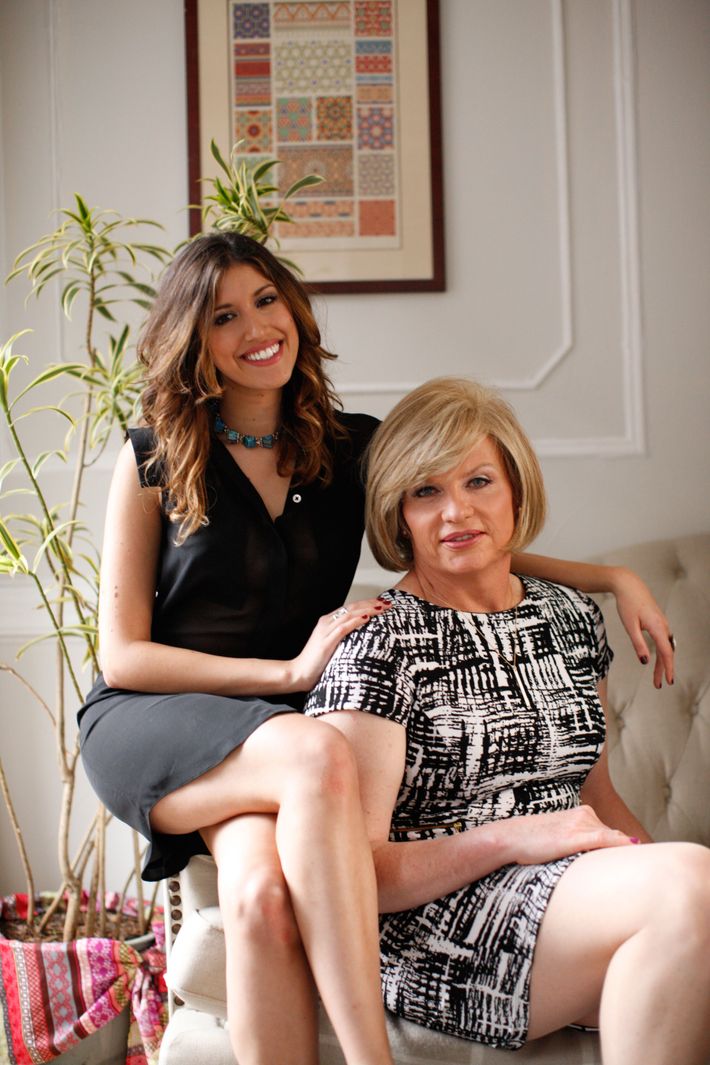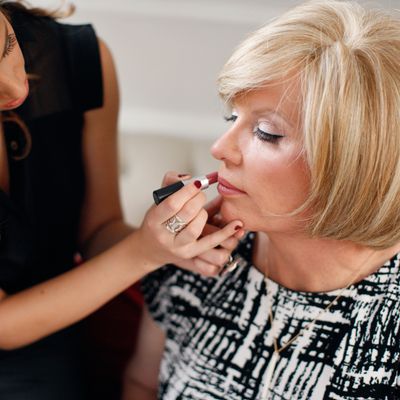
On a recent Friday afternoon, Stacey Johnson found herself in need of a wig. It’s not that she hadn’t brought a couple with her to New York from Los Angeles, where she lives. It’s just that the ones she brought weren’t doing her any favors.
“They’re like hair hats,” said Monica Prata, Stacey’s feminine image consultant. “Um, no.”
Which was exactly the kind of feedback that Stacey had hired Monica to deliver. Over the past seven years, and especially since founding her company Nouveau She in 2008, Monica has worked with hundreds of transgender women, helping them navigate the tricky terrain of feminine signifiers. For around $130 an hour, Monica’s standard rate as a stylist (“I’m not going to upsell them just because they’re trans”), she will provide hair, makeup, and wardrobe makeovers, not to mention guidance on facial feminization and gender reassignment surgery, vocal training, home redecoration, and “comportment.” She’s helped clients write letters to their families. She’s paced their transitions, recommending that they give themselves time to process each change as it comes. And she can be relied upon to give her honest opinion about what looks feminine—and what doesn’t. “Passable is kind of a dirty word. It’s not okay to impose upon somebody the idea that they need to look a certain way,” she’d told me earlier. “But if somebody comes to me and says, ‘I want to look and sound and talk completely like a woman,’ I’ll give them what they want.”
For Stacey, that means no hair hats. Especially not that night, which was to be a major milestone: For the first time, she was going to meet a member of her family in femme. It was a daunting prospect, and Stacey was anxious about how she would look. At that moment, she looked like a middle-aged dad in baggy jeans and a polo shirt. There was much to be done.

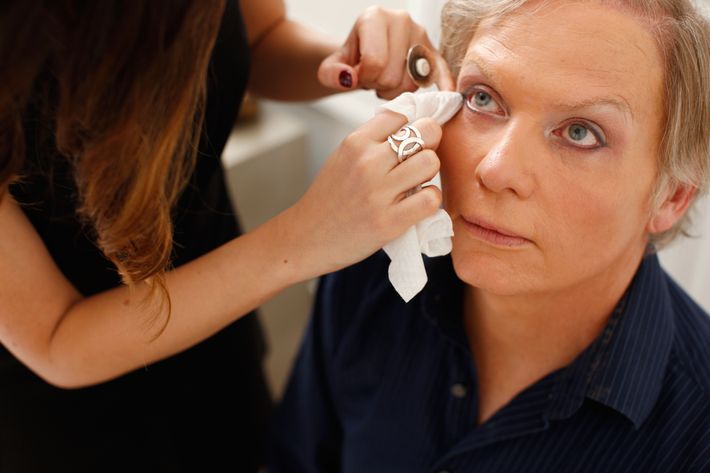
Though it was only Monica’s third face-to-face meeting with Stacey, they’d been in touch for months now. Monica knew that Stacey had always felt that she was really a woman, that her sisters caught her dressing in their clothes when she was 5, that she got married at 22 and her wife of 35 years had no idea about any of this, that she suffers from erectile dysfunction, that she dreams of taking hormones but worries that her family doctor will notice, that she wants a nose job, and that she’d prefer a long wig, one that she can feel swish and swing about her shoulders, even though Monica has repeatedly told her that a shorter one would look better.
“Remember, when hair gets too long, it loses its volume,” Monica said as Stacey tried on a long, drab wig at a store on the eighth floor of a building in the west 30s. “You look like a mom that’s taking her kids to the mall in the suburbs. Right? Like you drive a minivan,” said Monica, scrunching her nose. Next up was a wig that was dark and curly (“Oh my God! You’re like an Italian woman married to a guy in the mob — a really hot mob wife”), followed by a blonde (“Now you’re like a lady that works at a hair salon and frosts her hair — or Jennifer Aniston from Friends. This is ‘the Rachel!’”). They eventually settled on one of the very first wigs Stacey had tried, a lovely and pricey auburn number with I’ve-just-had-a-blowout waves, which they had trimmed by a very obliging saleslady. When the cut was over, the wig fell just below Stacey’s shoulders, a length that still had movement, but seemed appropriate for a professional woman in her 50s.
Stacey ran her fingers through it and tossed her head back and forth. “I like it,” she said, smiling.
Monica Prata possesses the sort of femininity that announces itself. Even without makeup and lugging an overnight bag through the bowels of Penn Station at a painfully early hour, she has a glamorously rumpled look — all mussed curls and slender curves. We’re heading to Washington, D.C., to meet two of her clients, and to introduce them to each other. (An ancillary service she provides is access to her extensive network of trans women.) These clients fit her main demographic: middle-aged, white, married with children, and upper-middle class. “They’ve lived most of their lives as white men, so they make white-man money,” Monica points out — a good thing, since transitioning can cost several hundred thousand dollars. Greta is a cardiologist and one of Monica’s “congruency” clients — someone who appreciates her maleness but also wants to tap into her feminine side; the goal is to find fluency between the two, not jettison one for the other. But Kimberly’s assigned gender weighs on her heavily. A former officer in the Marine Corps who wears a silver cross bracelet and frequently seems on the verge of tears, she would probably transition if it didn’t mean giving up her family and maybe even her faith.
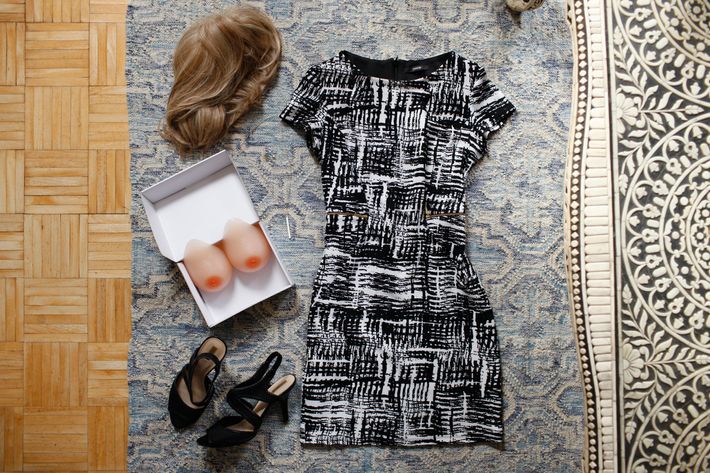
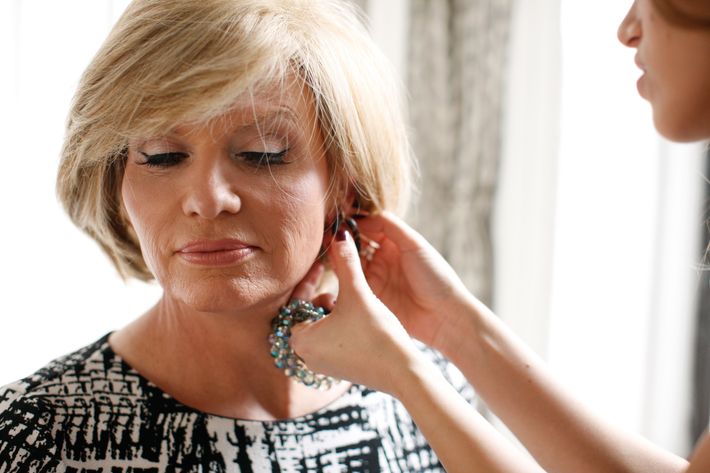
Despite these considerations, Monica thinks Kimberly will transition one day, or at least that she should — though she would only say that if Kimberly asked her directly. “My clients walk in my door and their deepest, darkest secret, the thing that they’re most ashamed of, that they’re most afraid of, that they have been hiding from everybody, is the very subject of our discussion,” she says. “It’s like starting at the core of a human being and working your way out.”
Monica stumbled into this line of work ten years ago when, as a 17-year-old salesperson at a Nordstrom department store in suburban Chicago, she’d notice guys coming in late at night to shop for girlfriends she was pretty sure didn’t exist. “They were like, ‘Oh, she’s gorgeous, but she’s a little bit broader and on the tall side,’ and I’d look for dresses that I knew would fit him and also a great pair of khakis” to give him an excuse to go in a dressing room and try it all on. She ran into the same issues later when she worked as a makeup artist at M.A.C: “When a guy approached the counter and said, ‘I want to get my makeup done as a woman,’ the other artists would be like, ‘Oh, are you in a play? Do you have a hickey or a blemish I’m covering up?’ I would watch this incredibly uncomfortable exchange happen constantly, and so I decided to work with all those customers.” But it wasn’t until she responded to a Craigslist ad for a personal stylist, and Randy turned out to want to be styled as Randi, that she realized that she’d stumbled upon a sort of calling. “It gave me a sense of empowerment that I didn’t have making an already beautiful woman more beautiful,” she says.
By then, Monica had also learned how few resources there were for the trans community. The scattered boutiques that catered to them peddled spandex miniskirts, thigh-high boots, and fishnet stockings. “The shittiest pieces of clothing for twice what they would cost you anywhere else,” says Monica. “It was as if that boutique was saying to that individual, ‘Your feminine self is only for sex. Your feminine self is only to be objectified.’ And that did not sit well with me.” Meanwhile, of the few male-to-female coaches out there (“I can count on two hands every person who sort of does what I do”), many had pageant backgrounds and taught that fun-house version of femininity that involves a toothy smile and a stiff walk. Others had more of a drag aesthetic, performative and brash rather than subtle and sincere. “One is a former porn star who asks you to take off all your clothes and pray to this pink candle,” Monica said, arching a perfectly plucked eyebrow. Then there were the transition studios with their stock wigs and stock makeup and stock clothing, and their imperative to fit into a certain cookie-cutter mold of femininity that doesn’t really exist in the natural world.
It was a reaction against this stock femininity that led Monica to question what femininity actually is. “We’re not necessarily reading that someone has a vagina,” she points out. “We’re reading that they look, behave, and sound like a woman. I mean, a lot of people view their gender on a social level, so it doesn’t make a difference what’s under their clothes.” If, she reasoned, her clients had a deeply felt internal identification based on their response to stimuli — a person can feel that they have a more typically “female” response or a more typically “male” one, despite how that person is socialized — then it was her job to give them congruency by helping the outgoing message match the incoming ones.
To further drive home the point that a vagina alone does not a female make, Monica has had clients come to her having fully transitioned, but still not feeling that society was accepting them as women. That’s when Monica, the stylist, realized she needed to expand her repertoire of services. But first, she needed to parse those gender signifiers that she, as a ciswoman, had learned by osmosis. “It takes a lot of observations, but I knew what I was looking for because my clients were telling me, ‘I don’t know what to do here.’”
Now she teaches her clients not just the obvious mannerisms of femininity — women have softer handshakes, for example — but the ones that operate on a more subconscious level: Women use more words to express the same ideas, they use more colorful language, they open their eyes more when they speak, they smile more, they lean forward more, they touch their faces, they touch each other, they keep their elbows closer to their bodies and take up less space in a room and apologize more and preface their opinions with qualifiers and are more likely to let themselves be interrupted.
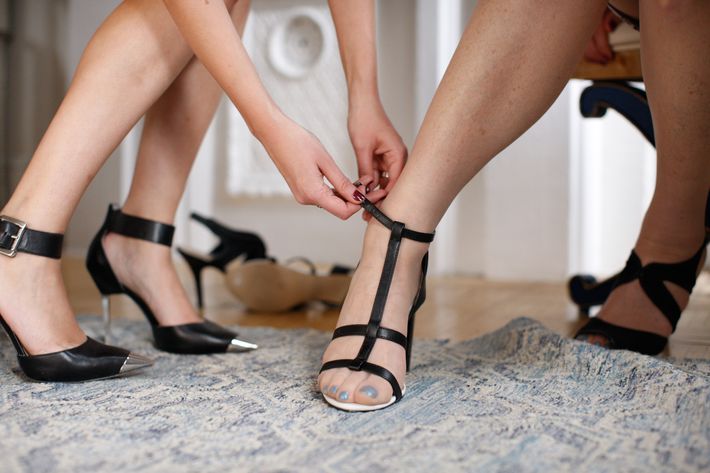
As a feminist, Monica finds many of these signifiers troubling: What does it say about society that the subconscious gender cues that cast women as submissive are the ones that actually work? At a panel late last year, feminist icon bell hooks attacked Orange Is the New Black star Laverne Cox for catering to stereotypes of femininity — a charge that Cox did not entirely dispute (“Am I feeding the patriarchal gaze with my blonde wig?” Cox asked. “Yes,” hooks quickly replied). Even to undertake the goal of mastering gender signifiers can be controversial in a culture that’s moving, haltingly, toward larger acceptance of the transgender community. Yet most of Monica’s clients don’t want to be viewed as trans; they want to be viewed as women, because that’s how they identify. “I feel like a woman when I’m dressed,” a longtime client who calls herself Robyn tells me. “It’s not a transgender persona, it’s a female persona.”
Monica doesn’t believe it’s fair to hold her clients to a higher standard than cisgendered women and demand that they buck traditional gender stereotypes. “I hate teaching the things I have to teach sometimes,” she says. “My hope is that we surpass our current idea of gender and sexuality as binary and that what I do becomes antiquated and ridiculous.” But until that day arrives, she doesn’t expect her clients to be feminist warriors. “So what, because they were socialized as men, now they have to overcompensate and be the women of all women? It doesn’t make sense.”
More tricky still are her attempts to teach her clients these signifiers while also deconstructing the stereotypes that she’s found aren’t helpful — particularly the thoroughly unmodern, and therefore unconvincing, idea that women should be coy and demure and keep their opinions to themselves. “A lot of my clients think that when they are in femme, if they go to a restaurant and order, say, a filet medium rare, and the filet comes to them medium well, they won’t send it back,” she tells me, by way of example. “They’ll be like, ‘Well, you know, I’m in femme, and it just doesn’t feel very feminine.’ And oh my God, it kills me that they think that suddenly because they look like a woman their right to have their food cooked the way they asked is stripped from them. I think it says a lot about how we socialize our men, right? Because the people who I work with were socialized as men to have an idea about what femininity is, about what being female means.” And what that subconscious idea entails is that women should not expect to get what they ask for or insist on having what they want.
What good would it do, though, to shame them, to make her clients feel more awkward for having been raised male? Instead, Monica very politely sends their steak back for them.
“I’m nervous,” Stacey said, back in her hotel room, surveying her wardrobe options and holding a paper cup half-full of sparkling wine meant to calm her nerves and also remind her that what she planned to do that night was worth celebrating. “I’m about to show the first member of my family Stacey, and I don’t think I’m ready to come out to everybody. It scares me.” She took a deep breath and looked over at Monica for reassurance.
Monica stopped unpacking her suitcase of makeup and raised her cup to Stacey. “To a big night. Your biggest night.”
“I’m starting to get more nervous now.”
“I know,” Monica said with a breeziness that implied that it would be strange if she weren’t.
“I’m thinking about taking a Xanax.”
“But you shouldn’t,” Monica advised, no longer breezy at all. “You should feel this. And you should remember that nervousness and excitement are really, really close to each other in terms of what they feel like. Just allow your body to morph that nervousness into eagerness to show this side of yourself for the first time ever to someone who loves you.”
Stacey nodded and pulled a lavender sweater from the pile. “I was thinking something like this.”
Once in femme clothing, wearing breast forms and padding to give herself a more feminine shape, Stacey grew contemplative, running through a list of times when she’d done something careless — left her bra in the laundry room, for instance — and risked having her wife discover her secret. According to Monica, 80 percent of her clients who transition stay married through that time, though they also tend to stay heteronormative, meaning that once they get far enough along in their transition, they find themselves attracted to men (a controversial theory chalks this up to hormones; Monica thinks it has more to do with social identification). More than half get divorced shortly after they transition completely. Occasionally, a client of Monica’s will get found out when her wife discovers a photo of her in femme, though the pictures are sometimes so good that the wife assumes her husband is having an affair instead.
“Do you ever feel like maybe you subconsciously want to get caught?” asks Monica as she dabs foundation over Stacey’s face.
“I wonder about that. I was going to ask my therapist to see what she says.”
“Seems likely.”
“All my life, I’ve been attracted to women,” Stacey muses. “As a guy, I’m not attracted to men, but I don’t know about when I’m a woman.”
“As a girl, would you say it’s kind of flexible?”
“Yeah. Which is the part of this whole thing that scares me the most. If I wasn’t married right now, would I be with a man as Stacey? No. But would I transition? Yes. Then would I be with a man? Yes. But the thing is, sure, maybe my wife would support me, but she’s not going to stay married to me.”
“But would you want to stay married to her?” Monica asks, as she begins to contour Stacey’s face with a blush brush, drawing out her cheekbones, narrowing her chin. “You’re not a lesbian.”
“I don’t know. And I won’t know until it happens.”
“Do you think it will happen? Do you think you will transition?”
Stacey considers. “If you asked me that a year ago, I’d say, ‘No, it’s not going to happen. I’m going to make sure it doesn’t happen.’ Now I don’t know. Now I think it will, I just don’t know when.”
“You think it will? Really?”
“Yeah,” Stacey softly admits.
Monica stops the brush in midair. “You’ve never said that before.”
“I know.” Stacey pauses. “I think I’ve only said it to myself.”
The music from the rooftop bar of the Americano Hotel thrummed loudly as Stacey crossed through the lounge area and ventured onto the dance floor, peering about expectantly. She looked soft, natural, and age-appropriate in a plum-colored sweater dress, black high-heeled booties, just the right amount of makeup, and her new auburn wig. When she saw her cousin across the room, she stiffened slightly. But her cousin enveloped her in a hug and led her to a back corner where they could talk. “She told me how beautiful I looked,” Stacey would tell us later. “Since we last talked, it seemed like she had educated herself on being transgender. All my nervousness just melted away completely.”
They talked about how different being transgender was from being gay, how it can be much harder on the people around you because you change into someone who can be unrecognizable. They talked about their childhood, their family. And they talked about how Monica was helping Stacey have the courage to live in her own skin. It was long after midnight when they parted ways, though Stacey didn’t want the night to end. After the rush of acceptance, she didn’t want to go back to her hotel alone. She dreaded the moment when she would have to pack Stacey’s things away, not knowing the next time she’d be able to wear them. But she had an early flight to catch, a wife and children she loved to return to. Back in her room, she removed the wig, tucking it back in the box it came in. She took off her dress. She looked at herself for a long moment in the bathroom mirror before, slowly and regretfully, she began washing the makeup off her face.
